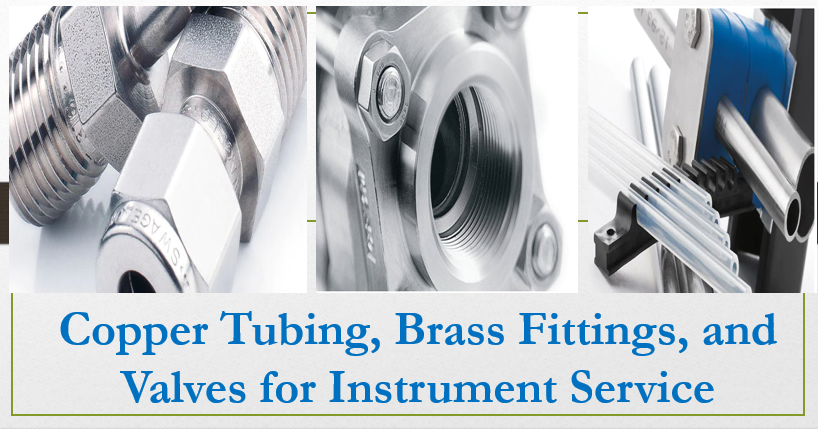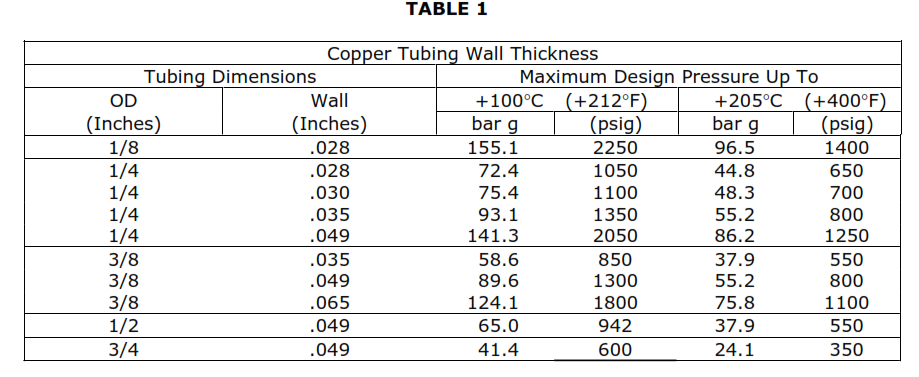This article is about Copper Tubing, Brass Fittings, and Valves for Instrument Service related to topic of Instrument Installation in Plants and Petrochemical Plants as per International Codes & Standards. Here furthermore will be discussed about Material Selection for Instrument Service, Tubing for Instrument Service, Fittings for Instrument Service, Valves for Instrument Service, Instrument Fittings Types, Instrument Fitting Size, Instrument Fittings Pdf, Instrumentation Tube Fittings, Instrument Fittings Types, Instrument Fittings Names Pdf, Instrument Tubing, Instrument Fittings India, Instrumentation Tube Fittings Manufacturer in Plant and Petrochemical Plants.
1. PURPOSE
This Article defines the criteria for the selection of copper tubing, brass fittings, and valves in all instrument services.
2. SCOPE
This article applies to all field instrument packages except instrumentation for ultra-high purity service.
Copper Tubing, Brass Fittings, and Valves for Instrument Service
3. Reference Standards and Codes
3.1 American Society for Testing and Materials (ASTM)
B16 Specification for Free-Cutting Brass Rod, Bar, and Shapes for Use in Screw Machines
B68 Specification for Seamless Copper Tube, Bright Annealed
B75 Specification for Seamless Copper Tube
B124 Specification for Copper and Copper-Alloy Forging Rod, Bar, and Shapes
B251 Specification for General Requirements for Wrought Seamless Copper and Copper Alloy Tube
3.2 American Society of Mechanical Engineers (ASME)
B31.3 Process Piping
4. Material Selection for Instrument Service
4.1 Copper tubing is the cost preferred material for instrumentation service. Limitations on its use are as follows:
4.1.1 The use of copper tubing shall be restricted to oxygen, nitrogen, air, argon, glycol, water, and other fluids or gases which are nontoxic, noncorrosive, and noncombustible.
Note: Even trace quantities of certain corrosive contaminants can preclude the use of copper.
4.1.2 Copper tubing may not be used in service above 295°C (400°F) nor for design pressures in excess of those tabulated in Table 1.
4.1.3 Because copper tubing fatigues in vibrating service and cracks at the stress points more quickly than does stainless steel, it may not be used where it might be subjected to sustained vibrations generated by equipment, such as reciprocating process compressors.
4.1.4 Copper tubing may not be used on process equipment unless it can be adequately supported and protected from mechanical damage. In these cases, stainless steel offers greater strength.
4.1.5 External corrosion risk in certain operating environments might prohibit the use of copper tubing for air supply and pneumatic lines because it could promote short life. This shall be reviewed with the project team at the start of all projects.
5. Tubing for Instrument Service
5.1 General Instrument Tubing sizes shall be as follows:
-
- Process tubing 3/8″ OD.
- Pneumatic signal tubing 1/4″ OD, for response speed.
- Analyzer sample tubing 1/4″ OD, for response speed.
- Instrument air supply tubing within 18 inches of user 3/8″ OD.
Note: The project team will review customer requested deviations from this standard.
5.2 Design pressures have been calculated using allowable stress values for ASME B31.3, ASTM B75, and B251 manufacturing tolerances.
5.3 Tubing shall be soft-annealed seamless copper per ASTM B68 or B75. Wall thickness shall be per Table 1.
Copper Tubing Wall Thickness Table 1
Following types of Copper / SS Tubing for Instrument Service can be used.
6. Fittings for Instrument Service
6.1 Compression fittings shall be Swagelok as manufactured by the Swagelok Company., Solon, Ohio, or Parker A-Lok manufactured by Parker Hannifin Corp., Huntsville, Alabama, and shall be brass made from rod or bar per ASTM B16 or from forgings per ASTM B124.
6.2 Compression fittings shall be supplied and used as complete assemblies.
6.3 Pipe fittings such as nipples, couplings, reducers, and plugs shall be hex-pattern brass precision fittings and shall be Cajon Brand, as manufactured by the Swagelok Company, or equivalent. Pipe fittings shall be assembled using Teflon pipe thread tape or oxygen compatible teflon pipe dope on all connections.
6.4 Mixing of compression fittings material (that is, brass and stainless steel) at a transition joint between copper and stainless steel tubing systems is prohibited. Transitions between tubing materials shall be accomplished by means of screwed fittings.
Following types of Fittings for Instrument Service can be used.
-
- Tube Fittings and Tube Adapters
- B Type VCO® L-Ring Face Seal Fittings
- Biopharm Fittings
- Cone and Thread Fittings
- Dielectric Fittings
- FK Series Medium-Pressure Tube Fittings
- Flange to Swagelok Tube Fittings
- PFA Fine Thread Flare Fittings
- Pipe Fittings
- Vacuum Fittings
- VCO® O-Ring Face Seal Fittings
- VCR® Metal Gasket Face Seal Fittings
- Weld Fittings
7. Valves for Instrument Service
7.1 Shut-off valves shall be integral bonnet needle type, forged brass, 206 bar g (3000 psig) at 40°C (100°F), with Type-316 stainless steel stem, PFA packing, and integral seat. Swagelok connections as manufactured by the Swagelok Company are the preferred connections. Threaded connections may be substituted when a Swagelok connection valve is not available.
7.2 Shut-off valves used in oxygen service shall be specified as oxygen cleaned and with a blue handle, by adding the suffixes “W1” and “BL” to the model number.
Example: B-xxxx-W1-BL.
7.3 Shut-off valves used in critical service applications, as indicated on the flowsheet at the process block valve by LO (Lock Open) or LC (Lock Closed), shall be specified with an orange handle by adding the suffix “OG” to the model number. A Nupro brand “Valve Lokout®” accessory, manufactured by the Swagelok company, shall be installed around the handle and secured with a nylon cable tie to prevent accidental closing or opening of the valve.
7.4 Ball valves shall be specified with a maximum pressure of 17 bar g (250 psig), spring-loaded packing to reduce the frequency of packing adjustments and extend the working temperature
range by adding a “T” to the model number (Example: B-xxTxx.). The preferred ball valves shall be Whitey “40” series manufactured by the Swagelok company.
Following types of Valves for Instrument Service can be used.
-
- Atomic Layer Deposition (ALD) Valves
- Ball Valves
- Bellows-Sealed Valves
- Bleed and Purge Valves
- Check Valves
- Diaphragm-Sealed Valves
- Excess Flow Valves
- Manifolds
- Medium-Pressure Ball Valves
- Medium-Pressure Double Block and Bleed Valves
- Medium- and High-Pressure Check Valves
- Medium- and High-Pressure Needle Shutoff and Regulating Valves
- Medium- and High-Pressure Relief Valves
- Metering Valves
- Needle Shutoff and Regulating Valves
- Process Interface Valves
- Quarter-Turn Plug Valves
- Relief Valves
- Sample Stream Select Valves
- Valve Locks

